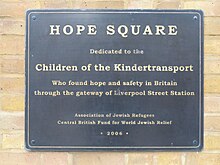



The Kindertransport (German for "children's transport") was an organised rescue effort of children from Nazi-controlled territory that took place in 1938–1939 during the nine months prior to the outbreak of the Second World War. The United Kingdom took in nearly 10,000 children,[1] most of them Jewish, from Germany, Austria, Czechoslovakia, Poland, and the Free City of Danzig. The children were placed in British foster homes, hostels, schools, and farms. Often they were the only members of their families who survived the Holocaust. The programme was supported, publicised, and encouraged by the British government, which waived the visa immigration requirements that were not within the ability of the British Jewish community to fulfil.[2][3] The British government placed no numerical limit on the programme; it was the start of the Second World War that brought it to an end, by which time about 10,000 kindertransport children had been brought to the country.
Smaller numbers of children were taken in via the programme by the Netherlands, Belgium, France, Sweden, and Switzerland.[4][5][6] The term "kindertransport" may also be applied to the rescue of mainly Jewish children from Nazi German territory to the Netherlands, Belgium, and France. An example is the 1,000 Chateau de La Hille children who went to Belgium.[3][7] However, most often the term is restricted to the organised programme of the United Kingdom.
The Central British Fund for German Jewry (now World Jewish Relief) was established in 1933 to support in whatever way possible the needs of Jews in Germany and Austria.
In the United States, the Wagner–Rogers Bill was introduced in Congress, which would have increased the quota of immigrants by bringing to the U.S. a total of 20,000 refugee children, but it did not pass.
- ^ Levy, Mike (2023). Get the Children Out! Unsung heroes of the Kindertransport. Lemon Soul, UK. p. 268. ISBN 978-1-999378141.
- ^ "Kindertransport". History Learning Site. July 2009. Retrieved 29 March 2019.
- ^ a b "Kindertransport; Organising and Rescue". The National Holocaust Centre and Museum. 12 December 2016. Retrieved 29 March 2019.
- ^ Mark, Jonathan (5 December 2018). "The Long Goodbye: Kindertransport Revisited 80 Years After". Jewish Week.
- ^ Thompson, Simon (20 December 2018). "Kindertransport survivor sees German payments as history acknowledged". Reuters.
- ^ Marcia W. Posner (2014). Zachor: Not Only to Remember; The Holocaust Memorial and Tolerance Center of Nassau County... Its First Twenty Years
- ^ "600 Child Refugees Taken From Vienna; 100 Jewish Youngsters Going to Netherlands, 500 to England". The New York Times. 6 December 1938. ISSN 0362-4331. Retrieved 29 March 2019.